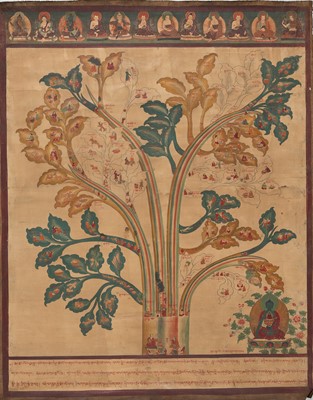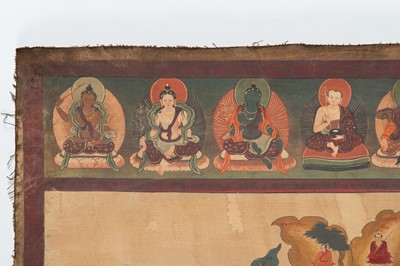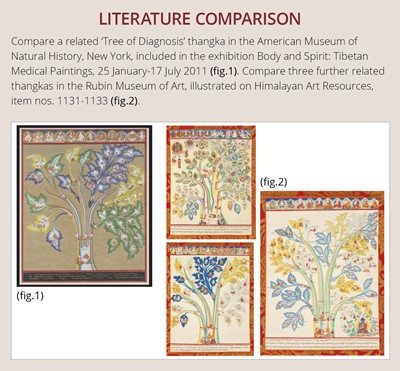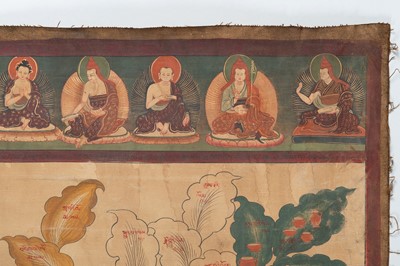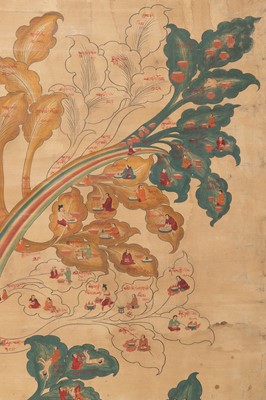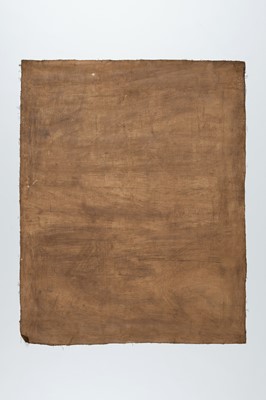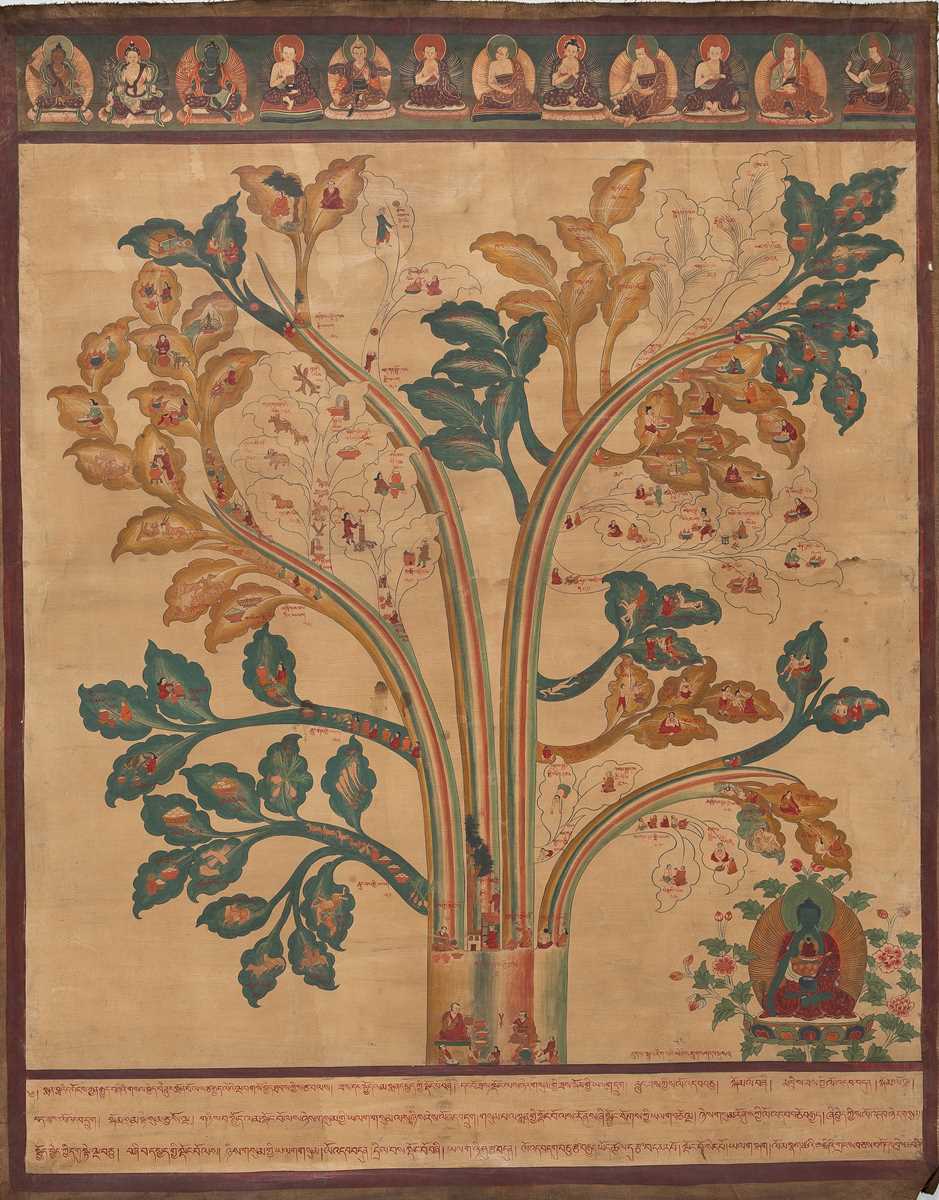13th Dec, 2023 13:00
Fine Asian Art Holiday Sale
53
A MEDICAL THANGKA WITH THE TREE OF DIAGNOSIS
Sold for €1,950
including Buyer's Premium
Tibet, 19th to early 20th century. Distemper and gold on cloth. Well painted in bright polychrome pigments, the central register with a large medical tree with four main stalks representing the four roots of treatment (diet, behavior, medication, and external therapy), with the blue-skinned Bhaisajyaguru (Medicine Buddha) seated in dhyanasana on a lotus pillow surrounded by a double aureole and peony blossoms to the right of the tree.
Provenance: From an Austrian private collection.
Condition: Very good condition with minor wear, minimal fading, light soiling, some staining, and minor fraying to edges.
Dimensions: Size 70 x 88.9 cm
The upper register is painted with twelve figures, consisting of both monks and deities, each flanked by a bright nimbus and halo. The lower register contains three lines of medical text.
This painting depicts the methods of treatment used in the Tibetan system of medicine. The first stem stands for diet treatment, which has six branches. The first two branches with ten and four blue leaves, respectively, show the diet and the drink best suited to treat lung disorders. The third and fourth branches with seven and five yellow leaves, respectively, stand for the diet and drink suitable for mkhris-pa disorders and the fifth and sixth branches with six and three white leaves, respectively, stand for the diet and drink recommended for bad-kan disorders.
The second stem illustrates behavioral treatment. It has three branches with two leaves each representing the behaviors beneficial for the three humors.
The third stem depicts the different medications. It has a total of 15 branches and 50 leaves. The first six branches each bear three leaves. These refer to the tastes and medicinal qualities favorable for treating rlung, mkhris-pa and bad-kan disorders, which are shown as blue, yellow, and white leaves. The seventh to the twelfth branches bear a total of 23 leaves representing different medicinal preparations: broth and medicinal butter, decoctions and powders, pills and specific medicinal powders.
The fourth stem stands for external therapies, which are generally used as a last resort after all other treatments fail. It consists of three branches. The two blue leaves on the first branch portray the external therapy used to treat rlung disorders. The three yellow leaves on the second branch stand for external therapies used to fight mkhris-pa disorders and the two white leaves on the third branch signify external therapies used on bad-kan disorders.
Literature comparison:
Compare a related ‘Tree of Diagnosis’ thangka in the American Museum of Natural History, New York, included in the exhibition Body and Spirit: Tibetan Medical Paintings, 25 January-17 July 2011. Compare three further related thangkas in the Rubin Museum of Art, illustrated on Himalayan Art Resources, item nos. 1131-1133.
Tibet, 19th to early 20th century. Distemper and gold on cloth. Well painted in bright polychrome pigments, the central register with a large medical tree with four main stalks representing the four roots of treatment (diet, behavior, medication, and external therapy), with the blue-skinned Bhaisajyaguru (Medicine Buddha) seated in dhyanasana on a lotus pillow surrounded by a double aureole and peony blossoms to the right of the tree.
Provenance: From an Austrian private collection.
Condition: Very good condition with minor wear, minimal fading, light soiling, some staining, and minor fraying to edges.
Dimensions: Size 70 x 88.9 cm
The upper register is painted with twelve figures, consisting of both monks and deities, each flanked by a bright nimbus and halo. The lower register contains three lines of medical text.
This painting depicts the methods of treatment used in the Tibetan system of medicine. The first stem stands for diet treatment, which has six branches. The first two branches with ten and four blue leaves, respectively, show the diet and the drink best suited to treat lung disorders. The third and fourth branches with seven and five yellow leaves, respectively, stand for the diet and drink suitable for mkhris-pa disorders and the fifth and sixth branches with six and three white leaves, respectively, stand for the diet and drink recommended for bad-kan disorders.
The second stem illustrates behavioral treatment. It has three branches with two leaves each representing the behaviors beneficial for the three humors.
The third stem depicts the different medications. It has a total of 15 branches and 50 leaves. The first six branches each bear three leaves. These refer to the tastes and medicinal qualities favorable for treating rlung, mkhris-pa and bad-kan disorders, which are shown as blue, yellow, and white leaves. The seventh to the twelfth branches bear a total of 23 leaves representing different medicinal preparations: broth and medicinal butter, decoctions and powders, pills and specific medicinal powders.
The fourth stem stands for external therapies, which are generally used as a last resort after all other treatments fail. It consists of three branches. The two blue leaves on the first branch portray the external therapy used to treat rlung disorders. The three yellow leaves on the second branch stand for external therapies used to fight mkhris-pa disorders and the two white leaves on the third branch signify external therapies used on bad-kan disorders.
Literature comparison:
Compare a related ‘Tree of Diagnosis’ thangka in the American Museum of Natural History, New York, included in the exhibition Body and Spirit: Tibetan Medical Paintings, 25 January-17 July 2011. Compare three further related thangkas in the Rubin Museum of Art, illustrated on Himalayan Art Resources, item nos. 1131-1133.
Zacke Live Online Bidding
Our online bidding platform makes it easier than ever to bid in our auctions! When you bid through our website, you can take advantage of our premium buyer's terms without incurring any additional online bidding surcharges.
To bid live online, you'll need to create an online account. Once your account is created and your identity is verified, you can register to bid in an auction up to 12 hours before the auction begins.
Intended Spend and Bid Limits
When you register to bid in an online auction, you will need to share your intended maximum spending budget for the auction. We will then review your intended spend and set a bid limit for you. Once you have pre-registered for a live online auction, you can see your intended spend and bid limit by going to 'Account Settings' and clicking on 'Live Bidding Registrations'.
Your bid limit will be the maximum amount you can bid during the auction. Your bid limit is for the hammer price and is not affected by the buyer’s premium and VAT. For example, if you have a bid limit of €1,000 and place two winning bids for €300 and €200, then you will only be able to bid €500 for the rest of the auction. If you try to place a bid that is higher than €500, you will not be able to do so.
Online Absentee and Telephone Bids
You can now leave absentee and telephone bids on our website!
Absentee Bidding
Once you've created an account and your identity is verified, you can leave your absentee bid directly on the lot page. We will contact you when your bids have been confirmed.
Telephone Bidding
Once you've created an account and your identity is verified, you can leave telephone bids online. We will contact you when your bids have been confirmed.
Classic Absentee and Telephone Bidding Form
You can still submit absentee and telephone bids by email or fax if you prefer. Simply fill out the Absentee Bidding/Telephone bidding form and return it to us by email at office@zacke.at or by fax at +43 (1) 532 04 52 20. You can download the PDF from our Upcoming Auctions page.
How-To Guides
How to Create Your Personal Zacke Account
How to Register to Bid on Zacke Live
How to Leave Absentee Bids Online
How to Leave Telephone Bids Online
中文版本的操作指南
创建新账号
注册Zacke Live在线直播竞拍(免平台费)
缺席投标和电话投标
Third-Party Bidding
We partner with best-in-class third-party partners to make it easy for you to bid online in the channel of your choice. Please note that if you bid with one of our third-party online partners, then there will be a live bidding surcharge on top of your final purchase price. You can find all of our fees here. Here's a full list of our third-party partners:
- 51 Bid Live
- EpaiLive
- ArtFoxLive
- Invaluable
- LiveAuctioneers
- the-saleroom
- lot-tissimo
- Drouot
Please note that we place different auctions on different platforms. For example, in general, we only place Chinese art auctions on 51 Bid Live.
Bidding in Person
You must register to bid in person and will be assigned a paddle at the auction. Please contact us at office@zacke.at or +43 (1) 532 04 52 for the latest local health and safety guidelines.
